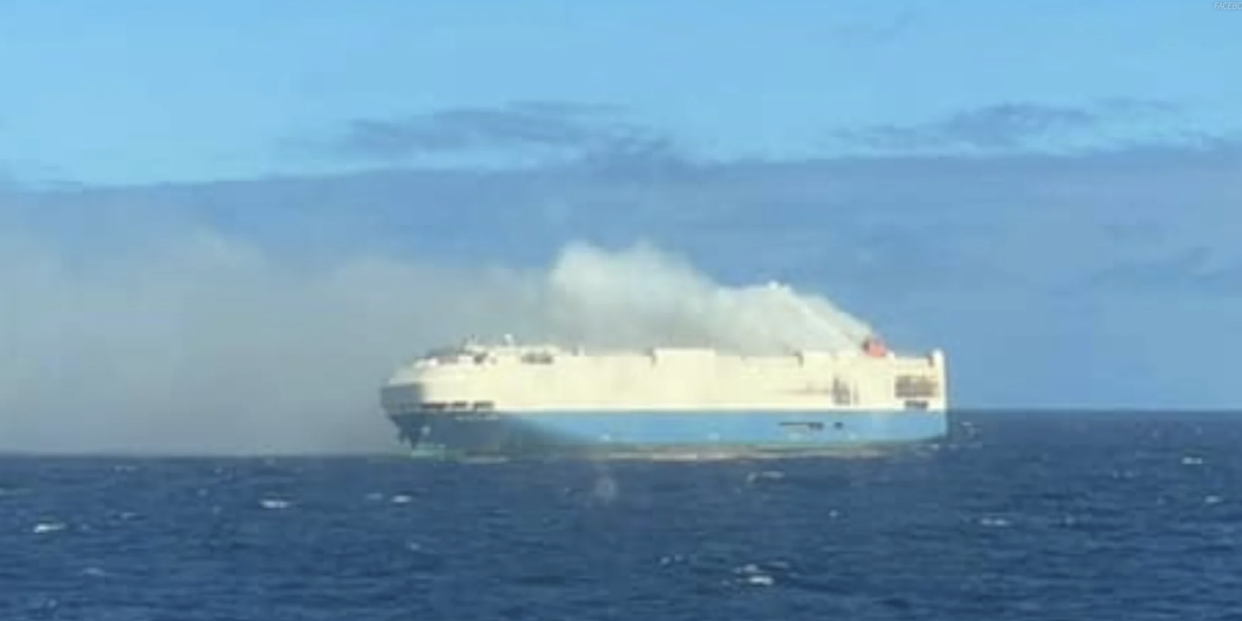The Porsche- and Lamborghini-Carrying Cargo Ship Has Sunk in the Atlantic Ocean

Felicity Ace, the car carrier that caught fire in the Atlantic last month with thousands of automobiles aboard, sunk on Tuesday morning.
The 22-person crew was safely evacuated from the ship the day of the fire broke out.
Salvage operations were underway to extinguish the flames, but lithium-ion batteries in the electric vehicles on board complicated efforts to put the fire out.
Thousands of cars—including Porsches, Volkswagens, and Lamborghinis—have gone down with the giant cargo ship Felicity Ace, which had been on fire in the Atlantic Ocean for nearly two weeks. A salvage operation was underway to take the roll-on-roll-off car carrier to a safe area off the Azores when it sank on Tuesday morning. The fire was out by the time the ship went under the waves.
The weather had been rough at the time, a spokesperson for Felicity Ace’s Japanese operator, Mitsui O.S.K. Lines transportation company, told Bloomberg. The ship sank after listing to starboard around 220 nautical miles off the Portuguese Azores archipelago at around 9 a.m. local time on March 1. Salvage craft remain posted at the site of the sinking to monitor the situation, according to a press release from the Felicity Ace Incident Information Centre.
🚗 You love cars. So do we. Take a spin with us—join Pop Mech Pro.
The crew of 22 safely abandoned the ship via helicopter and lifeboat on February 16, the day the blaze first broke out, according to FleetMon, a website that tracks ocean vessels. “The ship is burning from one end to the other ... everything is on fire about five meters above the water line,” Captain Joao Mendes Cabecas of the port of Hortas, told Reuters. The fire died down on February 25 after salvage operations began; its cause is still unknown.
The 656-foot-long vessel was traveling from Germany to the U.S., carrying Porches, Volkswagens, and possibly other cargo. Close to 4,000 vehicles were on board. Many of them were electric and contained lithium-ion batteries, which burn uncontrollably without a massive volume of water to put them out, according to Reuters. These situations require specialized equipment, and it often makes more sense to let the fire burn out on its own. Two tugs sprayed the vessel with water to cool the hull, and the salvage team was able to board Felicity Ace by helicopter. A large salvage craft with additional firefighting capability assisted the operation. By February 25, smoke emanating from the ship was no longer visible.
“Maritime salvage is a complex business,” Master Mariner Steven Browne tells Popular Mechanics. In most cases, like this one, the vessel owner will contract with a salvage company and the contract will specify the amount the salvor, a person who salvages a ship and items lost at sea, is paid. “The negotiated salvage fee could be a fixed amount or a variable amount based on the time and costs associated with the operation. If specified, the salvor may agree to a ‘No Cure, No Pay’ provision in which they wouldn’t get paid at all if the operation isn’t successful. The standard salvage contract that is used is Lloyd’s Open Form,” says Browne, a faculty member at California State University Maritime Academy in Vallejo, California.
If a vessel is salvaged without contract, the salvor needs to bring a salvage claim before a court. “The court will determine the value of the vessel and cargo, the risk to the salvors, and the danger to the vessel and cargo,” Browne says. In this case, it’s likely the award won’t top 50 percent of the total value of the ship and cargo. Most likely the salvor will get only 10 to 25 percent.
Unfortunately, it seems there is nothing left to salvage, as it has all gone down with the ship.
You Might Also Like

